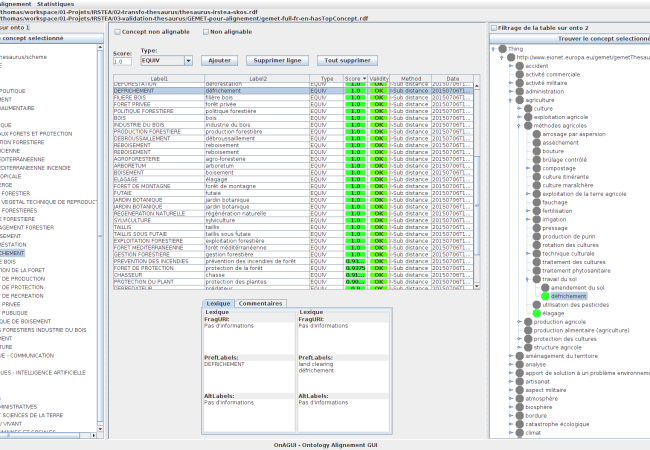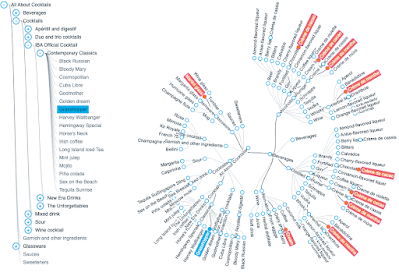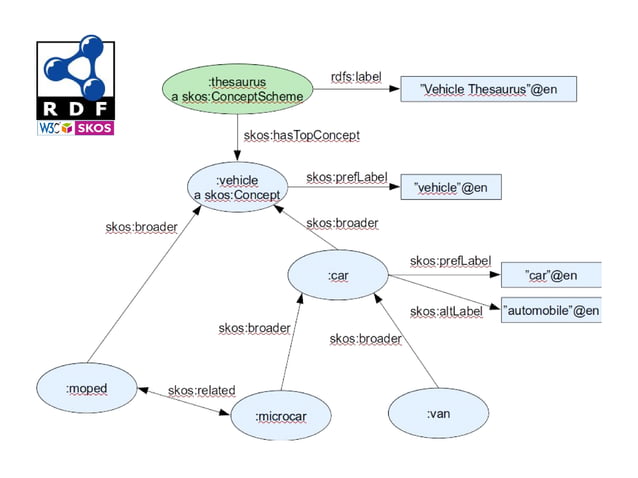110 Matching Annotations
- Feb 2024
-
demo.skosmos.org demo.skosmos.org
Tags
Annotators
URL
-
- Oct 2023
-
rdf.insee.fr rdf.insee.fr
- Aug 2023
-
direct.mit.edu direct.mit.edu
-
cso.kmi.open.ac.uk cso.kmi.open.ac.uk
-
thes.bncf.firenze.sbn.it thes.bncf.firenze.sbn.it
- Jul 2023
-
cv.iptc.org cv.iptc.org
- Jun 2023
-
jbarrasa.com jbarrasa.com
-
wdtaxonomy.readthedocs.io wdtaxonomy.readthedocs.io
-
mapping-commons.github.io mapping-commons.github.io
Tags
Annotators
URL
-
-
mapping-commons.github.io mapping-commons.github.io
-
linkedwiki.com linkedwiki.com
-
```sparql PREFIX pm20: http://purl.org/pressemappe20/folder/ PREFIX p: http://www.wikidata.org/prop/ PREFIX pq: http://www.wikidata.org/prop/qualifier/ PREFIX skos: http://www.w3.org/2004/02/skos/core# PREFIX wdt: http://www.wikidata.org/prop/direct/ PREFIX wd: http://www.wikidata.org/entity/
SELECT ?wd ?skosRelation ?pm20
construct {
?wd ?skosRelation ?pm20 .
}
where { service https://query.wikidata.org/sparql { # wd items with PM20 ID ?wd wdt:P4293 ?pm20Id . filter(isLiteral(?pm20Id)) # # mapping relation optional { ?wd p:P4293/pq:P4390 ?relation . # URL of the equivalent skos property ?relation wdt:P2699 ?skosRelation1 . } } # bind as URIs bind(uri(concat('http://purl.org/pressemappe20/folder/', ?pm20Id)) as ?pm20) bind(if(bound(?skosRelation1), ?skosRelation1, uri('http://www.w3.org/2004/02/skos/core#exactMatch')) as ?skosRelation) } ```
-
-
stackoverflow.com stackoverflow.com
-
stackoverflow.com stackoverflow.com
-
stackoverflow.com stackoverflow.com
-
-
campus.dariah.eu campus.dariah.eu
-
There are many different types of controlled vocabularies, the most common among them are: Thesaurus - a type of controlled vocabulary used in information systems that organizes concepts in hierarchical and/or associative relationships and provides their semantic definitions Classification schema - a system that based primarily on classifying things or concepts into groups or classes with a detailed explanation of those classification methods Subject heading list - a list of terms describing subjects in information system Taxonomy - a system that organizes things and concepts in groups based on their common characteristics and/or differences Terminology - a list of terms used to describe concepts in a certain domain Glossary - an alphabetical list of terms with their explanation used in a specific context
-
-
dossierdoc.typepad.com dossierdoc.typepad.com
-
www.cs.vu.nl www.cs.vu.nl
Tags
Annotators
URL
-
-
publications-prairial.fr publications-prairial.fr
-
id.loc.gov id.loc.gov
-
id.loc.gov id.loc.gov
-
jakobib.github.io jakobib.github.io
-
link.springer.com link.springer.com
-
-
vocabulary.mimo-international.com vocabulary.mimo-international.com
-
vocabulary.mimo-international.com vocabulary.mimo-international.com
- May 2023
-
accidental-taxonomist.blogspot.com accidental-taxonomist.blogspot.com
-
github.com github.com
-
```php
$record) { if ($name<>"count" and $name<>"specials") { foreach ($record["site"] as $sitelink) { $site[$sitelink["dbname"]]=$sitelink["url"]; } } if ($name==="specials") { foreach ($record as $sitelink) { $site[$sitelink["dbname"]]=$sitelink["url"]; } } } /* Open files */ $fp = fopen('data/'.$entity_proc.'.ttl', 'w'); fwrite($fp, "@prefix rdf: <http://www.w3.org/1999/02/22-rdf-syntax-ns#> .\n"); fwrite($fp, "@prefix rdfs: <http://www.w3.org/2000/01/rdf-schema#> .\n"); fwrite($fp, "@prefix skos: <http://www.w3.org/2004/02/skos/core#> .\n"); fwrite($fp, "@prefix wd: <http://www.wikidata.org/entity/> .\n"); fwrite($fp, "@prefix wdt: <http://www.wikidata.org/prop/direct/> .\n"); fwrite($fp,"\n"); fwrite($fp,"<http://www.wikidata.org/categories> rdf:type skos:ConceptScheme ;\n"); fwrite($fp," skos:prefLabel \"Wikidata categories\"@en .\n\n"); // echo $list_entities."\n"; $url = "https://www.wikidata.org/w/api.php?action=wbgetentities&ids=".$entity_proc."&props=labels|aliases|sitelinks&format=php&utf8="; $a = unserialize(file_get_contents($url)); foreach ($a["entities"] as $entity=>$data_entity) { fwrite($fp,"wd:".$entity." rdf:type skos:Concept ;\n"); fwrite($fp," skos:inScheme <http://www.wikidata.org/categories> "); if (isset($data_entity["labels"])) { foreach ($data_entity["labels"] as $label) { fwrite($fp,";\n skos:prefLabel \"".$label["value"]."\"@".$label["language"]." "); } } if (isset($data_entity["aliases"])) { foreach ($data_entity["aliases"] as $item) { foreach ($item as $label) { fwrite($fp,";\n skos:altLabel> \"".$label["value"]."\"@".$label["language"]." "); } } } foreach ($data_entity["sitelinks"] as $item) { if (in_array($item["site"],$array_sources)) { /* GET BROADER CATEGORIES */ $repeat_query=true; $cmcontinue=""; while ($repeat_query==true) { $repeat_query = false; $url_wiki = $site[$item["site"]]."/w/api.php?action=query&generator=categories&titles=".urlencode($item["title"])."&prop=pageprops|categoryinfo&format=php&utf8=".$cmcontinue; $b = unserialize(file_get_contents($url_wiki)); if (isset($b["continue"]["cmcontinue"])) { $repeat_query = true; $cmcontinue = $b["continue"]["cmcontinue"]; } if (isset($b["query"]["pages"])) { foreach ($b["query"]["pages"] as $broadcat) { if (isset($broadcat["pageprops"]["wikibase_item"])) { if (!isset($broader[$broadcat["pageprops"]["wikibase_item"]])) {$broader[$broadcat["pageprops"]["wikibase_item"]]=$broadcat["title"];} // fwrite($fp,"<http://www.wikidata.org/entity/".$entity_proc."> <http://www.w3.org/2004/02/skos/core#broader> <http://www.wikidata.org/entity/".$broadcat["pageprops"]["wikibase_item"]."> <http://www.wikidata.org/categories/".$item["site"]."> .\n"); } } } } /* GET NARROWER CATEGORIES */ $repeat_query=true; $cmcontinue=""; while ($repeat_query==true) { $repeat_query = false; $url_wiki = $site[$item["site"]]."/w/api.php?action=query&generator=categorymembers&gcmtitle=".urlencode($item["title"])."&gcmtype=subcat&prop=pageprops|categoryinfo&format=php&utf8=".$cmcontinue; $b = unserialize(file_get_contents($url_wiki)); if (isset($b["continue"]["cmcontinue"])) { $repeat_query = true; $cmcontinue = $b["continue"]["cmcontinue"]; } if (isset($b["query"]["pages"])) { foreach ($b["query"]["pages"] as $narrowcat) { if (isset($narrowcat["pageprops"]["wikibase_item"])) { if (!isset($narrower[$narrowcat["pageprops"]["wikibase_item"]]) or $item["site"]=="enwiki") {$narrower[$narrowcat["pageprops"]["wikibase_item"]]=$narrowcat["title"];} // fwrite($fp,"<http://www.wikidata.org/entity/".$entity_proc."> <http://www.w3.org/2004/02/skos/core#narrower> <http://www.wikidata.org/entity/".$narrowcat["pageprops"]["wikibase_item"]."> <http://www.wikidata.org/categories/".$item["site"]."> .\n"); } } } } } } } $prevalue=""; foreach ($broader as $target=>$value) { fwrite($fp,";".$prevalue."\n skos:broader wd:".$target); $prevalue=" # ".$value; } if ($prevalue!=="") {fwrite($fp,$prevalue);} $prevalue=""; foreach ($narrower as $target=>$value) { fwrite($fp,";".$prevalue."\n skos:narrower wd:".$target); $prevalue=" # ".$value; } if ($prevalue!=="") {fwrite($fp,$prevalue);} fwrite($fp,".\n\n"); fclose($fp); ?>```
Tags
Annotators
URL
-
-
slides.lobid.org slides.lobid.org
Tags
Annotators
URL
-
-
www.dublincore.org www.dublincore.org
-
github.com github.com
-
pro.europeana.eu pro.europeana.eu
Tags
Annotators
URL
-
-
europeana.atlassian.net europeana.atlassian.net
-
mondedulivre.hypotheses.org mondedulivre.hypotheses.org
-
databus.dbpedia.org databus.dbpedia.org
-
www.semanticscholar.org www.semanticscholar.org
-
eprints.rclis.org eprints.rclis.org
- Apr 2023
-
www.getty.edu www.getty.edu
Tags
Annotators
URL
-
-
vocab.getty.edu vocab.getty.edu
Tags
Annotators
URL
-
- Jan 2023
-
mondedulivre.hypotheses.org mondedulivre.hypotheses.org
Tags
Annotators
URL
-
-
lms.fun-mooc.fr lms.fun-mooc.fr
Tags
Annotators
URL
-
-
lms.fun-mooc.fr lms.fun-mooc.fr
-
www.ala.org www.ala.org
Tags
Annotators
URL
-
-
vocabulaires-ouverts.inrae.fr vocabulaires-ouverts.inrae.fr
-
www.slideshare.net www.slideshare.net
-
www.youtube.com www.youtube.com
-
-
www.slideshare.net www.slideshare.net
-
vocbench.uniroma2.it vocbench.uniroma2.it
-
vocabs.dariah.eu vocabs.dariah.eu
-
-
skosmos.org skosmos.orgSkosmos1
Tags
Annotators
URL
-
-
www.heppnetz.de www.heppnetz.de
Tags
Annotators
URL
-
-
www.w3.org www.w3.orgXKOS1
Tags
Annotators
URL
-
-
www.canal-u.tv www.canal-u.tv
-
www.canal-u.tv www.canal-u.tv
- Dec 2022
-
accidental-taxonomist.blogspot.com accidental-taxonomist.blogspot.com
-
accidental-taxonomist.blogspot.com accidental-taxonomist.blogspot.com
- Aug 2022
-
www.fao.org www.fao.org
Tags
Annotators
URL
-
- Jun 2022
-
github.com github.com
-
blog.skohub.io blog.skohub.io
-
SkoHub supports a novel approach for finding content on the web. The general idea is to extend the scope of Knowledge Organization Systems (KOS) to also act as communication hubs for publishers and information seekers. In effect, SkoHub allows to follow specific subjects in order to be notified when new content about that subject is published.
-
- May 2022
-
www.bobdc.com www.bobdc.com
Tags
Annotators
URL
-
-
gist.github.com gist.github.com
-
```sparql PREFIX rdf: http://www.w3.org/1999/02/22-rdf-syntax-ns# PREFIX skos: http://www.w3.org/2004/02/skos/core# PREFIX schema: http://schema.org/ prefix owl: http://www.w3.org/2002/07/owl# prefix rdfs: http://www.w3.org/2000/01/rdf-schema#
CONSTRUCT { http://schema.org/ a skos:ConceptScheme ; skos:hasTopConcept schema:Thing . ?child a skos:Concept ; skos:broaderTransitive ?parent ; skos:broader ?ancestors ; skos:prefLabel ?label ; skos:definition ?desc ; skos:inScheme ?ext . ?parent skos:narrowerTransitive ?child . ?ancestors skos:narrower ?child .<br /> } WHERE { ?child rdfs:subClassOf ?parent . ?child rdfs:subClassOf+ ?ancestors . OPTIONAL { ?child rdfs:label ?label } OPTIONAL { ?child rdfs:comment ?desc } OPTIONAL { ?child schema:isPartOf ?ext } } ```
-
-
mappings.dbpedia.org mappings.dbpedia.org
Tags
Annotators
URL
-
-
mappings.dbpedia.org mappings.dbpedia.orgOntology1
Tags
Annotators
URL
-
-
scigraph.springernature.com scigraph.springernature.com
-
bash $ curl -H 'Accept: application/ld+json' 'https://scigraph.springernature.com/pub.10.1007/978-0-387-89976-3_10' { "@context": "https://springernature.github.io/scigraph/jsonld/sgcontext.json", "about": [ { "id": "http://purl.org/au-research/vocabulary/anzsrc-for/2008/08", "inDefinedTermSet": "http://purl.org/au-research/vocabulary/anzsrc-for/2008/", "name": "Information and Computing Sciences", "type": "DefinedTerm" }, { "id": "http://purl.org/au-research/vocabulary/anzsrc-for/2008/0806", "inDefinedTermSet": "http://purl.org/au-research/vocabulary/anzsrc-for/2008/", "name": "Information Systems", "type": "DefinedTerm" } ], "author": [ { "affiliation": { "alternateName": "Counseling, Educational, Psychology, and Special Education Department, Michigan State University, 461 Erickson Hall, 48824-1034, East Lansing, MI, USA", "id": "http://www.grid.ac/institutes/grid.17088.36", "name": [ "Counseling, Educational, Psychology, and Special Education Department, Michigan State University, 461 Erickson Hall, 48824-1034, East Lansing, MI, USA" ], "type": "Organization" }, "familyName": "Reckase", "givenName": "Mark D.", "id": "sg:person.01166264366.27", "sameAs": [ "https://app.dimensions.ai/discover/publication?and_facet_researcher=ur.01166264366.27" ], "type": "Person" } ], "datePublished": "2009-05-22", "datePublishedReg": "2009-05-22", "description": "Computerized adaptive testing (CAT) is a methodology for constructing a test, administering it to an examinee, and scoring the test using interactive computer technology. This methodology has a history that is as long as that of interactive computing. An early summary of CAT methods is given in Weiss (1974). A detailed description of the development of an operational application for the Armed Services Vocational Aptitude Battery is given in (Sands 1997). There are also several books available that describe the basic components of CAT procedures (Wainer, Dorans, Flaugher, Green, Mislevy, Steinberg and Thissen 1990; Parshall, Spray and Davey 2002; van der Linden and Glas 2000) so the basic details of the methodology are not presented here. A review of that literature will show that most of the current CAT methodology is based on the assumption that a unidimensional IRT model accurately represents the interaction between persons and test items. In this chapter, the generalization of the CAT methodology to the multidimensional case is considered. To provide a framework for this material, a brief summary of the conceptual basis for CAT is provided.", "genre": "chapter", "id": "sg:pub.10.1007/978-0-387-89976-3_10", "inLanguage": "en", "isAccessibleForFree": false, "isPartOf": { "isbn": [ "978-0-387-89975-6", "978-0-387-89976-3" ], "name": "Multidimensional Item Response Theory", "type": "Book" }, "keywords": [ "interactive computing", "computer technology", "interactive computer technology", "computerized adaptive testing", "Armed Services Vocational Aptitude Battery", "adaptive testing", "operational applications", "basic components", "computing", "unidimensional IRT model", "CAT methodology", "methodology", "test items", "IRT models", "CAT procedure", "technology", "basic details", "framework", "detailed description", "applications", "conceptual basis", "multidimensional case", "generalization", "testing", "examinees", "model", "items", "method", "description", "brief summary", "detail", "persons", "MIRT", "batteries", "test", "CAT method", "components", "assumption", "development", "chapter", "summary", "basis", "literature", "book", "procedure", "interaction", "Weiss", "cases", "review", "history", "materials", "Earlier summaries" ], "name": "Computerized Adaptive Testing Using MIRT", "pagination": "311-339", "productId": [ { "name": "dimensions_id", "type": "PropertyValue", "value": [ "pub.1046349288" ] }, { "name": "doi", "type": "PropertyValue", "value": [ "10.1007/978-0-387-89976-3_10" ] } ], "publisher": { "name": "Springer Nature", "type": "Organisation" }, "sameAs": [ "https://doi.org/10.1007/978-0-387-89976-3_10", "https://app.dimensions.ai/details/publication/pub.1046349288" ], "sdDataset": "chapters", "sdDatePublished": "2022-05-10T10:51", "sdLicense": "https://scigraph.springernature.com/explorer/license/", "sdPublisher": { "name": "Springer Nature - SN SciGraph project", "type": "Organization" }, "sdSource": "s3://com-springernature-scigraph/baseset/20220509/entities/gbq_results/chapter/chapter_412.jsonl", "type": "Chapter", "url": "https://doi.org/10.1007/978-0-387-89976-3_10" }
Tags
Annotators
URL
-
-
scigraph.springernature.com scigraph.springernature.com
-
schema:ScholarlyArticle is used to describe journal articles; schema:Chapter is used to describe book chapters; schema:Book is used to describe books; schema:Periodical is used to describe journals; schema:Person is used to describe researchers (e.g. authors, editors, grant recipients) schema:MonetaryGrant is used to describe awarded research grants; schema:MedicalStudy is used to describe clinical trials; sgo:Patent is used to describe patents.

-
-
www.slideshare.net www.slideshare.net
-
data.culture.fr data.culture.fr
Tags
Annotators
URL
-
-
skos-play.sparna.fr skos-play.sparna.fr
Tags
Annotators
URL
-
-
skos.um.es skos.um.es
Tags
Annotators
URL
-
-
api.finto.fi api.finto.fi
-
- Apr 2022
-
www.w3.org www.w3.org
Tags
Annotators
URL
-
-
www.narcis.nl www.narcis.nl
Tags
Annotators
URL
-
-
bibliotheques.wordpress.com bibliotheques.wordpress.com
-
www.xml.com www.xml.com
Tags
Annotators
URL
-
- Mar 2022
-
joinup.ec.europa.eu joinup.ec.europa.eu
- Jan 2022
-
-
- Oct 2018
-
wiki.uib.no wiki.uib.no
-
nkos.slis.kent.edu nkos.slis.kent.edu
Tags
Annotators
URL
-
-
Tags
Annotators
URL
-
-
www.w3.org www.w3.org
-
-
www.w3.org www.w3.org
-
-
www.slideshare.net www.slideshare.net
- Feb 2017
-
labs.sparna.fr labs.sparna.fr
- Aug 2015
-
-
he SKOS approach allows an application designer to create new properties to capture this distinction, and to declare them as sub-properties of skos:broader:
-
However the SKOS vocabulary itself does not provide any mechanism for expressing that a given concept consists of a pre-coordination of other concepts
E.g., this is why it's difficult to represent complex LCSH headings using SKOS.
-


